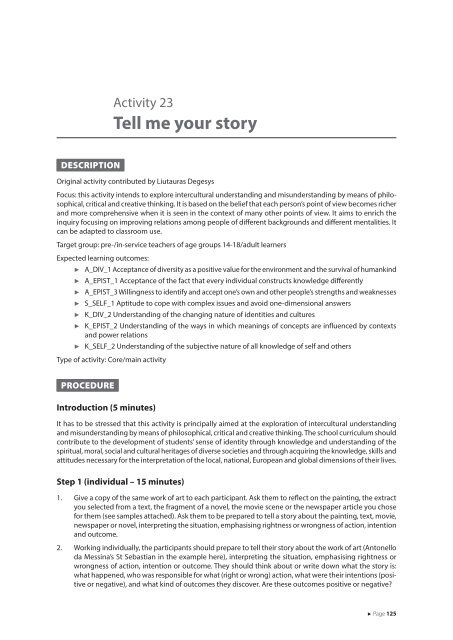TASKs for democracy
4NYw4W
4NYw4W
You also want an ePaper? Increase the reach of your titles
YUMPU automatically turns print PDFs into web optimized ePapers that Google loves.
Activity 23<br />
Tell me your story<br />
DESCRIPTION<br />
Original activity contributed by Liutauras Degesys<br />
Focus: this activity intends to explore intercultural understanding and misunderstanding by means of philosophical,<br />
critical and creative thinking. It is based on the belief that each person’s point of view becomes richer<br />
and more comprehensive when it is seen in the context of many other points of view. It aims to enrich the<br />
inquiry focusing on improving relations among people of different backgrounds and different mentalities. It<br />
can be adapted to classroom use.<br />
Target group: pre-/in-service teachers of age groups 14-18/adult learners<br />
Expected learning outcomes:<br />
<br />
<br />
<br />
<br />
<br />
<br />
A_DIV_1 Acceptance of diversity as a positive value <strong>for</strong> the environment and the survival of humankind<br />
A_EPIST_1 Acceptance of the fact that every individual constructs knowledge differently<br />
A_EPIST_3 Willingness to identify and accept one’s own and other people’s strengths and weaknesses<br />
S_SELF_1 Aptitude to cope with complex issues and avoid one-dimensional answers<br />
K_DIV_2 Understanding of the changing nature of identities and cultures<br />
K_EPIST_2 Understanding of the ways in which meanings of concepts are influenced by contexts<br />
and power relations<br />
K_SELF_2 Understanding of the subjective nature of all knowledge of self and others<br />
Type of activity: Core/main activity<br />
PROCEDURE<br />
Introduction (5 minutes)<br />
It has to be stressed that this activity is principally aimed at the exploration of intercultural understanding<br />
and misunderstanding by means of philosophical, critical and creative thinking. The school curriculum should<br />
contribute to the development of students’ sense of identity through knowledge and understanding of the<br />
spiritual, moral, social and cultural heritages of diverse societies and through acquiring the knowledge, skills and<br />
attitudes necessary <strong>for</strong> the interpretation of the local, national, European and global dimensions of their lives.<br />
Step 1 (individual – 15 minutes)<br />
1. Give a copy of the same work of art to each participant. Ask them to reflect on the painting, the extract<br />
you selected from a text, the fragment of a novel, the movie scene or the newspaper article you chose<br />
<strong>for</strong> them (see samples attached). Ask them to be prepared to tell a story about the painting, text, movie,<br />
newspaper or novel, interpreting the situation, emphasising rightness or wrongness of action, intention<br />
and outcome.<br />
2. Working individually, the participants should prepare to tell their story about the work of art (Antonello<br />
da Messina’s St Sebastian in the example here), interpreting the situation, emphasising rightness or<br />
wrongness of action, intention or outcome. They should think about or write down what the story is:<br />
what happened, who was responsible <strong>for</strong> what (right or wrong) action, what were their intentions (positive<br />
or negative), and what kind of outcomes they discover. Are these outcomes positive or negative?<br />
Page 125


